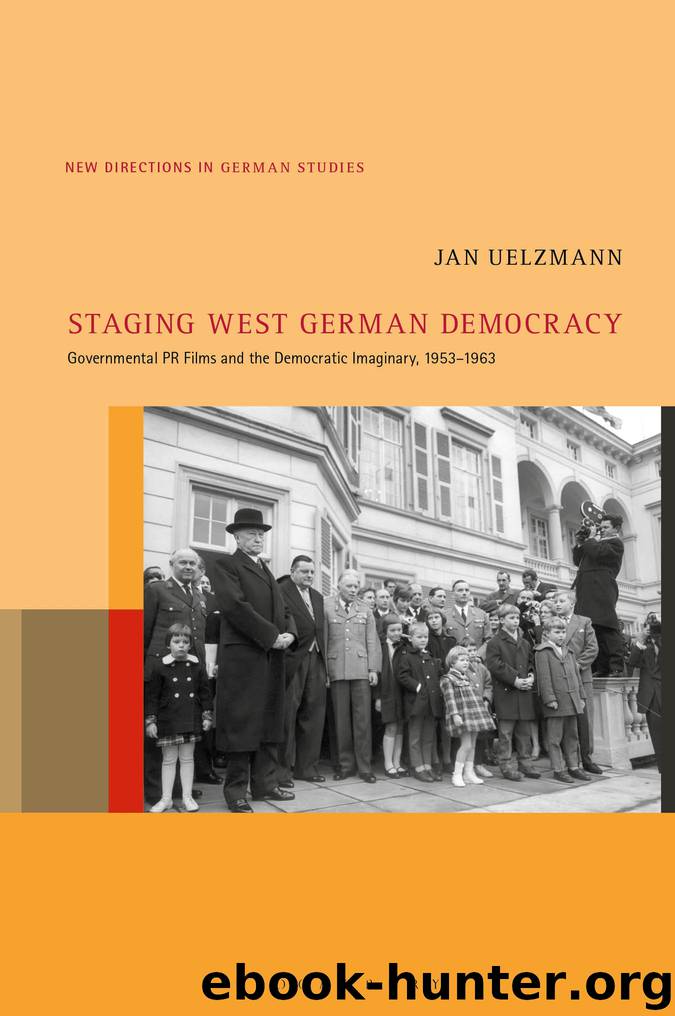Staging West German Democracy by Jan Uelzmann;

Author:Jan Uelzmann;
Language: eng
Format: epub
ISBN: 9781501347115
Publisher: Bloomsbury USA
Published: 2019-01-29T16:00:00+00:00
Conclusion: A Failed PR Film?
Meeting in the Kremlin lends itself well as a case study of the political function of Deutsche Wochenschau PR films as “government channels” in West Germany’s otherwise democratic media landscape. By creating an unambiguously positive image of Adenauer, the film helped cement the chancellor’s media image of the patriarchal elder statesman. By focusing on Adenauer’s diplomatic skill in its reporting on the negotiations in Moscow, the film highlights his status as an undeterred Cold Warrior, who took it upon himself personally to finally bring Germany’s “lost sons” home. Correspondingly, the old woman’s hand kiss on the airfield assumes the quality of a personal tribute that highlights Adenauer’s singularly elevated status among West German politicians.
Most of the scenes discussed in this chapter deal with families, and by extension with Germany as a whole. While the film’s laudatory reporting on the negotiations in Moscow highlights Adenauer’s function as a politician whose policies are based on broad political consensus and executed in the best interest of West Germany, the images of homecoming and reunion symbolically close the book on the traumatic German experience in the aftermath of Operation Barbarossa. Presented as a direct result of Adenauer’s policies, these images allow for mourning for those who perished, celebrate the return of the ones that survived and the reunion with their families, and serve as a sobering reminder that such a war must never happen again.
By vaguely alluding to German guilt, while always balancing it against a much more detailed narrative German of victimhood, the ending of Meeting in the Kremlin aims to symbolically overcome a haunted, very recent past. Along the lines of Adenauer’s retort in Moscow, that “also in Germany, terrible things happened,” the film meets the West German audience’s expectations by confidently highlighting German victim status, while the narrative of German perpetration, which explains the POWs’ miserable existence in Soviet camps for more than ten years, is omitted. During the onset of the economic miracle in 1956, this film offered its West German audience an opportunity to finally turn the page on a lingering and highly disturbing chapter of recent history. According to Uta Schwarz, who has examined the regular Neue Deutsche Wochenschau reporting on the event, the reunion images from Friedland represent a “symbolical capstone of the war” to the West German audience of 1956.95 With the last of the remaining POWs back on German soil, the film suggests that West Germans now are ready to direct their attention fully to the future. In the narrative logic of the film, this closure was given to West Germans solely by the political talent and diplomatic skill of their chancellor, Konrad Adenauer.
At the same time, as evidenced by its rather complicated production history, the film proved inherently problematic for the Press Office. The year 1955 was a time of heightened anti-communist sentiment in the Federal Republic, as well as in the US, which during that time experienced McCarthyism and the “Red Scare.” The Press Office’s concerns that the film
Download
This site does not store any files on its server. We only index and link to content provided by other sites. Please contact the content providers to delete copyright contents if any and email us, we'll remove relevant links or contents immediately.
Call Me by Your Name by André Aciman(19902)
Ready Player One by Cline Ernest(13981)
How to Be a Bawse: A Guide to Conquering Life by Lilly Singh(7154)
Wiseguy by Nicholas Pileggi(5315)
The Kite Runner by Khaled Hosseini(4952)
On Writing A Memoir of the Craft by Stephen King(4662)
Audition by Ryu Murakami(4612)
The Crown by Robert Lacey(4572)
Call me by your name by Andre Aciman(4463)
Gerald's Game by Stephen King(4374)
Harry Potter and the Cursed Child: The Journey by Harry Potter Theatrical Productions(4314)
Dialogue by Robert McKee(4160)
The Perils of Being Moderately Famous by Soha Ali Khan(4064)
Dynamic Alignment Through Imagery by Eric Franklin(3919)
Apollo 8 by Jeffrey Kluger(3512)
How to be Champion: My Autobiography by Sarah Millican(3493)
The Inner Game of Tennis by W. Timothy Gallwey(3472)
Seriously... I'm Kidding by Ellen DeGeneres(3412)
Darker by E L James(3407)
